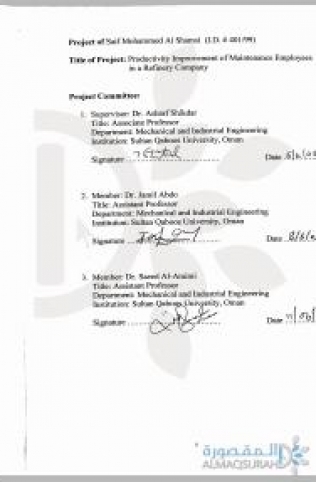
Maintenance cost is a significant portion of total operational costs of companies where productivity of maintenance workforce contributes a major role in the control of the overall maintenance cost. Today's industrial environment demands that maintenance productivity problems be solved and labor productivity improved Labor productivity of maintenance workforce at Oman Refinery Company (ORC) continued to be a bottleneck in the process of overall maintenance performance and efficiency that concerned maintenance management at ORC. In this project, the underlying reasons for maintenance workforce productivity problems in ORC were examined and improvement process was initiated, implemented and results were measured. Productivity measurement technique that directly involved the employees by actual reporting of delay hours was adopted. Overcoming the resistance to measure productivity, educating management and personnel on the benefits that would be gained from improved productivity, and make them accept that everyone wins when productivity is improved were the first steps towards productivity improvement. Areas needing productivity improvements were recognized and immediate actions were made for implementation. Detailed time analysis for the 8 hours shift of maintenance workers was conducted and factors influencing labor utilization and limiting labor productivity were identified. Analysis showed that maintenance workforce uses up to 32% of the shift duration in non-productive activities and hence, personnel were available to do productive work for only 68% of the total time. Results of 2 months measurement of actual time delays in executing maintenance works showed that additional 5% of the total paid man-hours were further wasted due to delays affecting the labor productivity. The improvement process initiated by the adoption of 100 days "Together We Shall Make the Difference" Productivity Improvement Campaign and continued after the campaign period had resulted in significant improvement in maintenance productivity. The average monthly delay hours were reduced by more than 39% during the 100 days of the campaign period. This had continued to reduce further to 56% in next 8 months after the campaign period. The monthly average number of work orders completed during the campaign had increased by 30.5% compared to work orders completed before the campaign. This improvement continued to sustain during the next 8 months after the campaign period. Maintenance backlog was reduced from 4.2 man-weeks to 3.5 man-weeks during the campaign period. Backlog continued to reduce further to 2.3 man-weeks at the end of 8 months after the campaign period. Maximum retention of a work order in the backlog had reduced from 14.7 months to 7.6 months. Total actual man-hours spent and times taken to execute the jobs were improved. In the first example, actual man-hours spent and time taken to execute the same job were improved by 43% and 50% respectively. In the second example, actual man-hours spent and time taken to execute the same job were improved by 22% and 35% respectively. The commitment and ownership by management and employees, empowered role of leadership, full participation from all maintenance employees and management, and regular feedback on the level of achievements, identification and correction of delays and making active steps to constantly improve productivity had made the achieved improvements in productivity possible. Campaign has successfully achieved its intended objective in creating and inculcating a culture that appreciates productivity and interested in improving it. Moreover, the campaign had achieved invaluable amount of learning and intangible benefits that are beyond measurements like the establishment of a teamwork spirit, improved communication, encouraged workers attitudes to accept measuring productivity, instilled the willingness and desire among employees to achieve better results, and establishing a partnership with operations department.
Maintenance cost is a significant portion of total operational costs of companies where productivity of maintenance workforce contributes a major role in the control of the overall maintenance cost. Today's industrial environment demands that maintenance productivity problems be solved and labor pro...